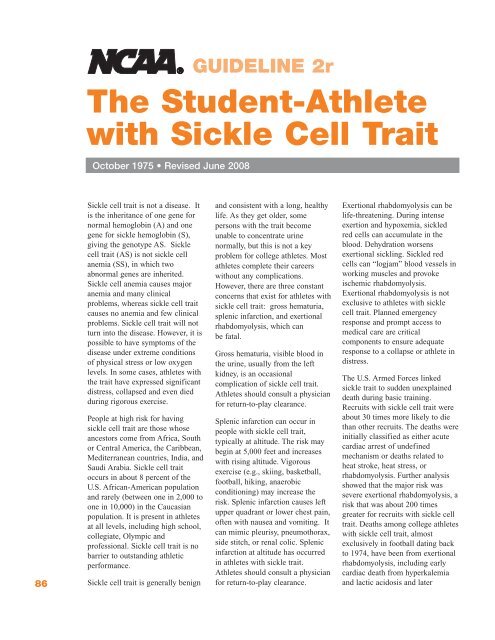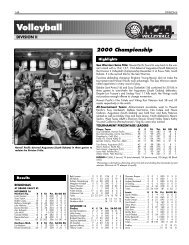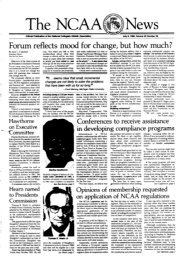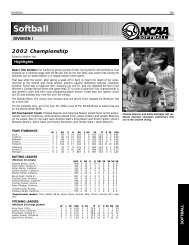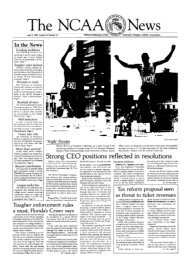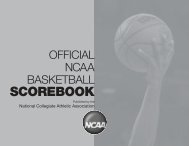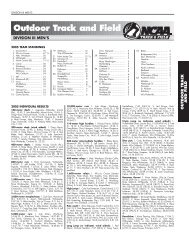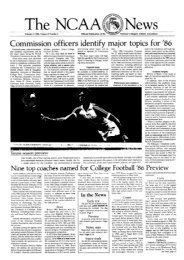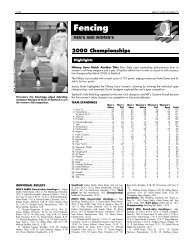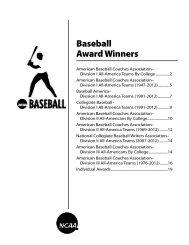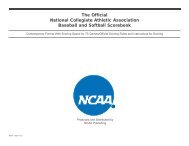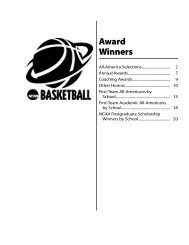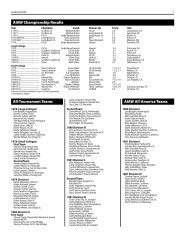Sports Medicine Handbook - NCAA
Sports Medicine Handbook - NCAA
Sports Medicine Handbook - NCAA
Create successful ePaper yourself
Turn your PDF publications into a flip-book with our unique Google optimized e-Paper software.
86<br />
The Student-Athlete<br />
with Sickle Cell Trait<br />
October 1975 • Revised June 2008<br />
Sickle cell trait is not a disease. It<br />
is the inheritance of one gene for<br />
normal hemoglobin (A) and one<br />
gene for sickle hemoglobin (S),<br />
giving the genotype AS. Sickle<br />
cell trait (AS) is not sickle cell<br />
anemia (SS), in which two<br />
abnormal genes are inherited.<br />
Sickle cell anemia causes major<br />
anemia and many clinical<br />
problems, whereas sickle cell trait<br />
causes no anemia and few clinical<br />
problems. Sickle cell trait will not<br />
turn into the disease. However, it is<br />
possible to have symptoms of the<br />
disease under extreme conditions<br />
of physical stress or low oxygen<br />
levels. In some cases, athletes with<br />
the trait have expressed significant<br />
distress, collapsed and even died<br />
during rigorous exercise.<br />
People at high risk for having<br />
sickle cell trait are those whose<br />
ancestors come from Africa, South<br />
or Central America, the Caribbean,<br />
Mediterranean countries, India, and<br />
Saudi Arabia. Sickle cell trait<br />
occurs in about 8 percent of the<br />
U.S. African-American population<br />
and rarely (between one in 2,000 to<br />
one in 10,000) in the Caucasian<br />
population. It is present in athletes<br />
at all levels, including high school,<br />
collegiate, Olympic and<br />
professional. Sickle cell trait is no<br />
barrier to outstanding athletic<br />
performance.<br />
Sickle cell trait is generally benign<br />
GUIDELINE 2r<br />
and consistent with a long, healthy<br />
life. As they get older, some<br />
persons with the trait become<br />
unable to concentrate urine<br />
normally, but this is not a key<br />
problem for college athletes. Most<br />
athletes complete their careers<br />
without any complications.<br />
However, there are three constant<br />
concerns that exist for athletes with<br />
sickle cell trait: gross hematuria,<br />
splenic infarction, and exertional<br />
rhabdomyolysis, which can<br />
be fatal.<br />
Gross hematuria, visible blood in<br />
the urine, usually from the left<br />
kidney, is an occasional<br />
complication of sickle cell trait.<br />
Athletes should consult a physician<br />
for return-to-play clearance.<br />
Splenic infarction can occur in<br />
people with sickle cell trait,<br />
typically at altitude. The risk may<br />
begin at 5,000 feet and increases<br />
with rising altitude. Vigorous<br />
exercise (e.g., skiing, basketball,<br />
football, hiking, anaerobic<br />
conditioning) may increase the<br />
risk. Splenic infarction causes left<br />
upper quadrant or lower chest pain,<br />
often with nausea and vomiting. It<br />
can mimic pleurisy, pneumothorax,<br />
side stitch, or renal colic. Splenic<br />
infarction at altitude has occurred<br />
in athletes with sickle trait.<br />
Athletes should consult a physician<br />
for return-to-play clearance.<br />
Exertional rhabdomyolysis can be<br />
life-threatening. During in tense<br />
exertion and hypoxemia, sickled<br />
red cells can accumulate in the<br />
blood. Dehydration worsens<br />
exertional sickling. Sickled red<br />
cells can “logjam” blood vessels in<br />
working muscles and provoke<br />
ischemic rhabdomyolysis.<br />
Exertional rhabdomyolysis is not<br />
exclusive to athletes with sickle<br />
cell trait. Planned emergency<br />
response and prompt access to<br />
medical care are critical<br />
components to ensure adequate<br />
response to a collapse or athlete in<br />
distress.<br />
The U.S. Armed Forces linked<br />
sickle trait to sudden unexplained<br />
death during basic training.<br />
Recruits with sickle cell trait were<br />
about 30 times more likely to die<br />
than other recruits. The deaths were<br />
initially classified as either acute<br />
cardiac arrest of undefined<br />
mechanism or deaths related to<br />
heat stroke, heat stress, or<br />
rhabdomyolysis. Further analysis<br />
showed that the major risk was<br />
severe exertional rhabdomyolysis, a<br />
risk that was about 200 times<br />
greater for recruits with sickle cell<br />
trait. Deaths among college athletes<br />
with sickle cell trait, almost<br />
exclusively in football dating back<br />
to 1974, have been from exertional<br />
rhabdomyolysis, in cluding early<br />
cardiac death from hyperkalemia<br />
and lactic acidosis and later


